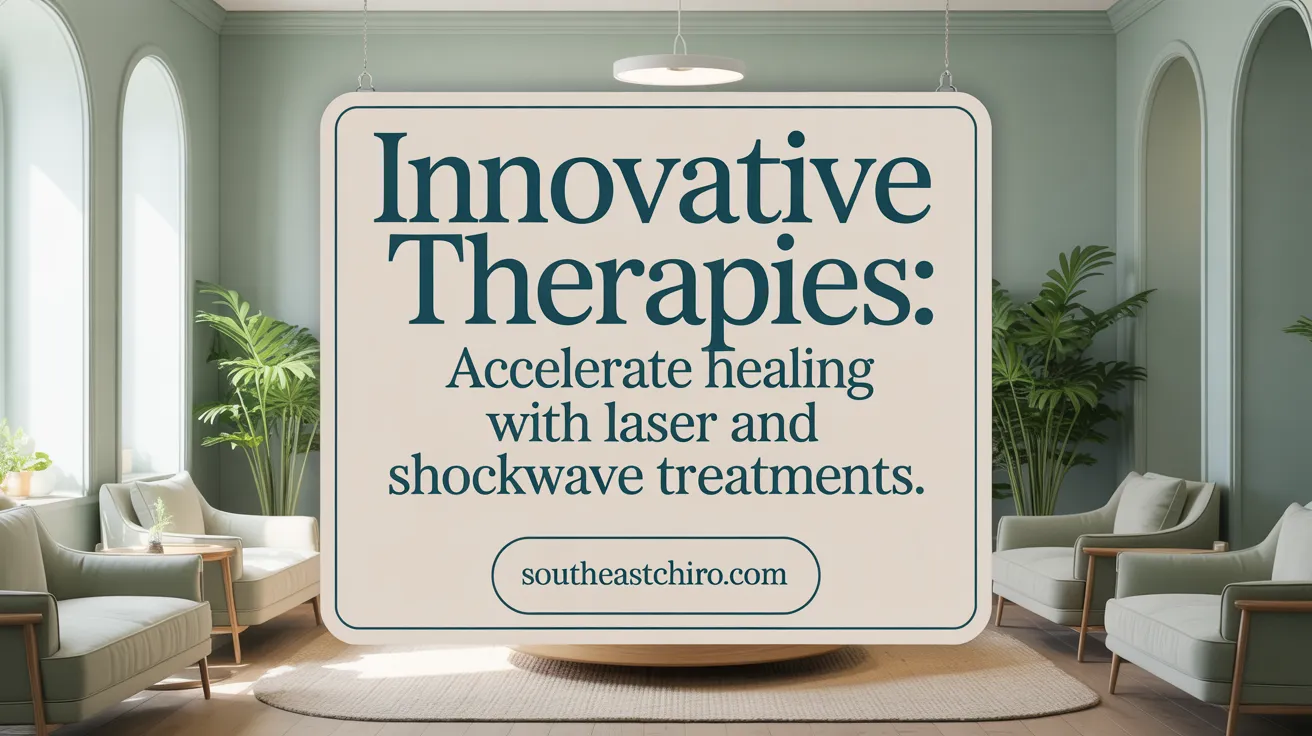Introducing a New Era in Chiropractic Care
Holistic Chiropractic Philosophy
Chiropractic care today embraces a holistic philosophy, focusing on treating patients as whole individuals rather than isolated symptoms. This approach aims to restore overall health and potential through non-invasive and natural treatment methods. By emphasizing lifelong wellness, chiropractic practices seek to improve patients' mobility, function, and quality of life.
Integration of Natural Care with Technology
Modern chiropractic care integrates time-honored natural approaches with cutting-edge technology. Clinics now employ advanced diagnostic tools such as digital X-rays, MRI scans, SEMG (Surface Electromyography), and thermography. Technologies like laser therapy, extracorporeal shock wave therapy, and automated adjustment systems allow precise, personalized treatment plans. These innovations enhance the safety and effectiveness of care, enabling drug-free and minimally invasive healing.
Patient-Centered Wellness Approach
Patient well-being is central to contemporary chiropractic practice. Care plans are tailored individually, supported by thorough diagnostics and ongoing monitoring through electronic health records and telehealth platforms. Educational resources and rehabilitation exercises empower patients to engage actively in their recovery. This comprehensive approach fosters collaboration between practitioner and patient, promoting sustained wellness and improved health outcomes.
Embracing a Holistic Approach to Spinal Health and Wellness

What is the holistic approach to spinal health and wellness in chiropractic care?
The holistic approach to spinal health and wellness in chiropractic care goes beyond just treating back pain. It emphasizes the treatment of the whole person — body, mind, and spirit — to promote overall health. Chiropractors focus on improving nervous system function through chiropractic adjustment care, which can positively affect sleep quality, mental clarity, energy levels, and even digestive and hormonal balance.
This comprehensive care includes nutritional counseling, ergonomic tips, and posture correction tailored to each individual's needs. By addressing the root causes of discomfort and dysfunction, holistic chiropractic care works to prevent future health concerns and enhance whole-body wellness.
Personalized care is a cornerstone, especially for sensitive groups such as pregnant women and children. Specialized prenatal chiropractic care techniques help manage pain, support fetal positioning, and improve postpartum recovery. Family chiropractic care ensures proper growth, development, and nervous system function across all ages.
Non-invasive strategies underline holistic chiropractic treatments. These emphasize natural, drug-free methods such as gentle spinal adjustments, rehabilitative exercises, soft tissue therapies, and advanced technologies that aid diagnosis and healing. This approach fosters balance, reduces stress on the body, and promotes proactive well-being without surgery or pharmaceuticals.
Advanced Technologies Enhancing Diagnosis and Treatment Precision

Digital Diagnostics Like X-rays and MRI
Modern chiropractic care heavily relies on advanced digital diagnostics in chiropractic care to enhance precision in diagnosis and treatment planning. Technologies such as use of digital X-rays and MRI scans offer detailed and clear imaging of spinal conditions, allowing practitioners to identify issues more accurately. These tools aid in detecting spinal misalignments, disc problems, and nervous system anomalies, supporting targeted and effective treatment strategies.
Surface Electromyography and Thermography
Surface Electromyography (SEMG) and thermography are important diagnostic technologies used to assess muscle activity and nervous system health. SEMG measures muscle tone along the spine to detect abnormal muscle behavior linked to vertebral misalignments. Thermography evaluates nerve and musculoskeletal function through temperature differences, helping chiropractors pinpoint sources of pain and dysfunction for tailored care.
INSiGHT Scanning Technology and ProAdjuster
Specialized scanning technologies like the INSiGHT Scanning Technology can quickly evaluate nervous system function, scanning in as little as 8 minutes to provide a comprehensive overview of neurological health. The ProAdjuster, originally developed from aerospace technology, offers precise assessment and mobilization of spinal segments. These innovations enable chiropractors to perform objective, data-driven assessments that increase safety and treatment effectiveness.
Data-Driven, Non-Invasive Treatment
With these technologies, chiropractic care moves beyond subjective evaluations toward technology-enhanced non-invasive treatments. Real-time imaging and muscle activity measurements allow for precise adjustments and rehabilitation without surgery or medications. Tools such as disc decompression machines and laser therapies complement these assessments by promoting natural healing processes in a safe and drug-free manner.
Technology Supporting Natural Healing
Modern chiropractic technology emphasizes natural, holistic healing. By integrating digital diagnostics and objective data collection, practitioners can provide personalized chiropractic treatment plans that restore mobility, reduce inflammation, and accelerate tissue repair. This technological support aligns with chiropractic’s core philosophy of non-invasive, drug-free approaches with digital tools focused on optimizing the body’s innate ability to heal.
Laser and Rehabilitation Therapies: Complementing Chiropractic Adjustments

How does laser therapy complement chiropractic treatment?
Laser therapy complements chiropractic treatment by providing a non-invasive laser treatment to promote healing and reduce pain. It uses Low Level Laser Therapy (LLLT) or cold laser light, which penetrates the skin to decrease inflammation and accelerate tissue repair.
Cold laser therapy mechanisms and benefits
Cold laser therapy, also known as Low Level Laser Therapy (LLLT), uses specific wavelengths of red or near-infrared light to stimulate cellular repair through photobiomodulation. This enhances circulation, promotes faster healing of damaged tissues, and offers relief from acute and chronic pain conditions without surgery or medication.
Reducing inflammation and accelerating healing
By increasing blood flow and cellular metabolism, laser therapy helps reduce inflammation and swelling in injured or painful areas. This creates an optimal environment for healing, minimizing recovery time and improving function.
Extracorporeal shock wave therapy
Another complementary modality is extracorporeal shock wave therapy, which applies focused shockwaves to muscle and tendon injuries. This treatment promotes blood vessel formation, accelerates tissue regeneration, and decreases pain, fitting well alongside chiropractic adjustments.
Rehabilitative exercises for recovery and strength
Chiropractors often incorporate rehabilitation exercises such as stretching, strengthening, joint mobility, and foam rolling. These exercises improve muscle tone, flexibility, and overall strength, supporting the adjustments and aiding long-term recovery.
Combining therapies for optimal results
Integrating laser therapy and shock wave therapy with chiropractic care and rehabilitative exercises maximizes patient outcomes. Laser and shockwave therapies prepare and heal tissues, while chiropractic adjustments realign joints and restore movement. Rehabilitation then strengthens muscles and improves flexibility to sustain results.
Non-invasive and drug-free pain management
Together, these therapies provide a holistic, drug-free, and non-invasive chiropractic treatment approach to pain relief and recovery. This comprehensive strategy reduces the need for surgery or pharmaceuticals, helping patients achieve lasting health improvements through digital diagnostics in chiropractic care and natural healing processes.
Creating an Accessible and Trustworthy Patient Experience Online

What patient resources are typically provided on a chiropractic practice website?
Chiropractic websites usually offer a variety of patient resources designed to assist and educate visitors. These include educational content explaining different chiropractic treatments like rehabilitation exercises and laser therapies. Online appointment scheduling and downloadable new patient intake forms add convenience, allowing patients to easily book visits and prepare ahead.
Many sites provide detailed insurance information and transparent pricing to address financial concerns upfront. Videos showcasing treatment procedures such as Cold Laser Therapy and post-care instructions help patients understand what to expect and support recovery.
Patient testimonials and success stories are commonly featured, giving new patients insight and confidence by presenting real experiences from clinics like Gastonia Spine & Sport. Contact details, office hours, and office locations ensure visitors can easily plan their appointments. These elements collectively create a supportive and informative environment that helps patients feel prepared and valued.
How does a chiropractic website foster trust and accessibility for patients?
Trust is built through clear, user-friendly design and comprehensive information about providers and services. Websites that present the chiropractors' credentials, experience, and personal introductions—such as those found at Integrative Chiropractic & Natural Medicine Indian Trail or Better Day Chiropractic Charlotte NC—create a sense of professionalism and reliability.
Offering features like online booking and clearly stated policies and pricing fosters transparency and convenience. Educational content about spinal health and wellness, including topics like digital diagnostics in chiropractic care, encourages patients to view the practice as a knowledgeable partner in their care.
Smooth navigation enhances engagement by allowing patients to find information quickly and intuitively. This reduces frustration and makes the site welcoming, especially for those seeking answers or support.
In summary, a well-designed chiropractic website combines clear communication, transparency, and easy access to services and information—drawing from resources like Chiropractic adjustment care and prenatal chiropractic care—to create a trustworthy and accessible experience for patients.
The Environmental Impact and Benefits of Tech-Enabled Natural Care
How does technology reduce reliance on pharmaceuticals and invasive procedures?
Tech-enabled chiropractic care at clinics like Arrowhead Clinic's state-of-the-art facilities promotes natural healing by using advanced diagnostics and treatments such as use of digital X-rays and MRI scans, Laser Therapy for Pain and Tissue Repair, and ReHab Spinal System Disc Decompression. These tools enhance precision and effectiveness, reducing the need for pharmaceuticals or surgeries, which often have higher environmental costs due to manufacturing, disposal, and medical waste.
How does telehealth expand access to chiropractic care?
Therapy through telehealth platforms allows remote consultations and real-time progress monitoring, making chiropractic care accessible to those in rural or mobility-limited situations. This reduces patient travel, lowering carbon emissions, and helps maintain consistent care without the environmental costs associated with in-person visits.
How do electronic health records improve efficiency?
The use of Electronic Health Records (EHR) in chiropractic streamlines data management and patient tracking. This digitization decreases paper use and reduces errors, making the delivery of chiropractic services more efficient and environmentally friendly.
How do these technologies support sustainable, non-invasive wellness?
By integrating precise digital diagnostics in chiropractic care, technology-enhanced non-invasive treatments, including laser therapy chiropractic care, and remote monitoring solutions for patients, chiropractic practices can focus on drug-free, non-invasive treatments. This approach aligns with environmental sustainability by limiting resource-intensive medical interventions and promoting the body's natural healing processes.
What are the local community benefits of combining advanced technologies with natural chiropractic approaches?
Locally in areas like Gastonia NC chiropractor and technology-enabled chiropractic care in Georgia, technologically advanced clinics provide personalized, natural care with modern tools. This combination improves wellness outcomes, reduces healthcare waste, and supports community health through patient education with visual aids and accessible, eco-friendly care.
Overall, embracing technology in chiropractic care offers environmental benefits by promoting natural treatments, minimizing waste, cutting down on travel emissions, and supporting sustainable healthcare practices.
Towards a Balanced Future in Chiropractic Wellness
Combining Natural Care with Modern Technology
Chiropractic wellness is evolving by integrating natural care with cutting-edge technology. Clinics like Arrowhead Clinic use digital imaging and tools such as the ProAdjuster and laser therapy to deliver precise, drug-free treatments. This blend ensures personalized care that respects the body's natural healing while benefiting from advanced diagnostics.
Enhancing Patient Well-being Holistically
Chiropractors emphasize treating patients as whole persons, focusing on pain relief and long-term health. Rehabilitation exercises, posture guidance, and lifestyle education complement hands-on adjustments to promote overall wellness and functional recovery.
Accessibility and Trust in Chiropractic
Local practices in Gastonia and beyond prioritize patient trust by offering a range of services including telehealth and supporting diverse populations such as pregnant women and accident victims. Insurance acceptance and experienced providers further enhance accessibility and confidence in care.
Commitment to Sustainable Health Solutions
The focus on non-invasive, conservative treatments aligns with sustainable health goals. Techniques that reduce reliance on surgeries and medications help patients maintain mobility and quality of life, illustrating chiropractic commitment to enduring health outcomes.
